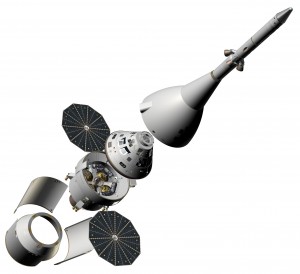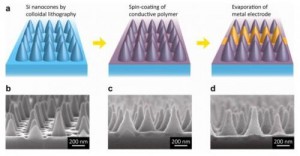Alphasat and Insat 3-D/Ariane 5 Launch
This was a launch of the massive Ariane 5 rocket on July 25th, 2013 at 19:54 UTC from French Guiana carrying a total of 9760 kg into geostationary orbit. The payloads were Alphasat I-XL, which was put into up for Immarsat‘s Broadband network service, and INSAT 3-D, which is an Indian space research satellite.
The Ariane 5 is the workhorse of the European Space Agency, and there was very little by way of drama in this launch – it was just very pretty to watch. The Ariane 5 was intended as a human-rated launch system, so after its first few troubled years it’s been very reliable. Unfortunately, they scrapped the manned spaceplane Hermes that Ariane 5 was supposed to carry, so it has not been used for manned missions. It does carry the unmanned Automated Transfer Vehicle (ATV) to the International Space Station.
NASA’s Orion Spacecraft
The Orion spacecraft is the vehicle NASA plans to use to extend the reach of manned spaceflight beyond Low Earth Orbit. Originally, it would have been perched on top of the Ares I launch vehicle, which was tested . . . but then canceled. Now, it will be on top of the Delta IV Heavy rocket for missions to LEO – like getting crew to the International Space Station – and eventually boosted up by the Space Launch System for more far-flung destinations.
The basic stats for the spacecraft are as follows:
Diameter: 5m
Habitable Volume: 316 cubic feet (8.95 cubic meters)
Capsule Mass: 8913 kg
Service Module Mass: 12337 kg (7907 kg propellant)
Crew: 2-6
Delta-V: 1595 m/s
Endurance (with current service module configuration): 21.1 days
Using 3-D Printers to Make Rocket Parts? Done.
Yes, according to this July 24th article on NASA’s website, not only can they manufacture injectors using 3-D printers at a substantially cheaper cost than by traditional methods, but the 3-D printed parts actually perform better. You can get all the juicy details from the NASA article – as usual, I’d like to talk about the broader implications. But first, how about a video of the part at work, enduring the 6,000 degree Fahrenheit temperatures it needs to:
Sometimes, NASA seems to be going at a snail’s pace that drives me nuts, but it looks like they’re on the cutting edge here, along with SpaceX, which is also using 3-D printers to make their parts.
Of course, every science fiction enthusiast has to be thinking replicators, right? And this is definitely going to be another case of science fiction becoming science fact, but let’s think about what this means for the next generation or so without getting all Star Trek about it. Think about Mars, or any future space base. Now, if something goes wrong, they won’t need the part manufactured on Earth and set on a potentially months-long delay. Instead, they’ll be taking a 3-D printer and some raw materials with them, and if they need to replace a part, they can manufacture it on-site without delay. This dramatically reduces the risks to any people we choose to send out there – especially for those sent to Mars.
NASA Orion Spacecraft Parachute Test
In case you missed it, this is NASA’s livestream of the test of the Orion parachute system by dropping it from 35,000 feet on July 24th, 2013:
Just a warning: the sound quality is absolutely horrendous. People commenting on the livestream suggested that someone connected to the Google Hangout left their mike on. Anyway, if Orion ends up going to Mars, then this would be the equivalent to watching the parachute tests on the Apollo CSM – not to be missed.
I’ll do a write-up with more details of the Orion spacecraft soon.
SpaceX’s Merlin 1D Test-Firing
The Merlin 1D engine will be used on the Falcon 9 and Falcon Heavy rockets to boost heavy loads into orbit. It’s at the very heart of SpaceX‘s most ambitious aspirations (so far), and I think the video of the test speaks for itself.
Congratulations to the SpaceX team. It looks like their hard work is really paying off, and I’m eager to see what they manage to do next.
Nanopollution in the Air
In an article a few weeks ago, I noted the way the synthetic particle cerium oxide had a tendency to stick around in incinerators, seeming indestructible. While worrying, this was not an immediate concern because cerium oxide is non-toxic, though it did suggest the need for more rigorous testing of all the chemicals we are putting into products – especially nano-scale synthetics that might pose a particular clean-up problem.
Well, research from Trinity College in Dublin might show that we’re already behind the curve on this. You can read the phys.org article on it here. Basically, the research showed that exposure carbon-based and silicon-based nanotechnology, including carbon nanotubes, can lead to rheumatoid arthritis and autoimmune diseases, as established by tests on human respiratory cells and on mice.
So, we now know that much of the new nanotechnology being developed may have serious health impacts. What we don’t know is where all the particles are going to end up or how easy or difficult it might be to clean it all up. Since many of the chemicals being developed are proprietary and treated as corporate secrets, there’s no guarantee that we’ll know what the new materials might be used in.
As the Guardian notes here, nanotechnology exists in a gaping hole in the regulatory framework, and companies are taking full advantage of the fact. Analysis of potential risks is virtually nonexistent. The question is, can university research money going to studies like that from Trinity College in Dublin keep up with the research and development money in the private sector. I think we know what the answer is.
Nanocones for Cheap Solar Cells
This dovetails on the article about the solar-powered airplane. While the efficiency of solar panels is critical to making them worth deploying as an alternative to fossil fuels, that’s only half the issue. The other half, of course, is price. Right now, the cost is a dollar a watt, which is pretty hefty. Fortunately, increasing efficiency and decreasing price go hand-in-hand. In an earlier article, we introduced the idea that adding wrinkles might make the cells more efficient, and therefore cheaper. This time, it’s a different method of increasing surface area: cones.
Of course, because these are really small cones, they are dubbed “nanocones,” and the Stanford University study was published in “Nano Letters.” There will come a point where we will have to stop using nano- to prefix to everything that’s in the nanometer range, since most technology already incorporates components in that range, and in the near future, all of it will. We’ll need to be a bit more specific. After all, we already have carbon nanocones, which are altogether different in application from these silicon cones. But that’s just a pet-peeve of mine – for now, nano’s captured everyone’s imagination, so I guess we’ll go with it everywhere we can.
The key to the cost-savings of this design is the space between the cones. In a normal polymer cell, you need a full second layer for the polymer, but with this design, it can simply fill the gaps. Having a second layer involves using other materials, so this method renders those unnecessary.

